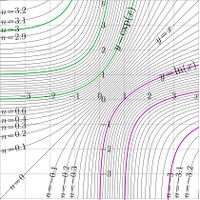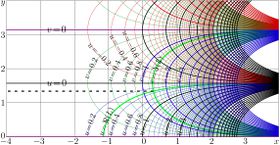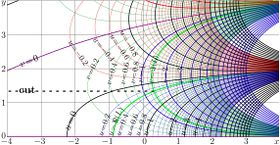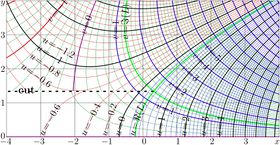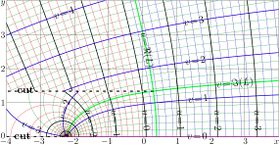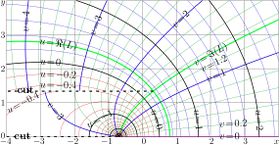Difference between revisions of "Iterate of exponential"
| Line 48: | Line 48: | ||
Complex maps of the $n$th iteration of exponential, $f=\exp^n(x+\mathrm i y)$ are shown in figures at right with |
Complex maps of the $n$th iteration of exponential, $f=\exp^n(x+\mathrm i y)$ are shown in figures at right with |
||
| − | lines $u=\Re(f |
+ | lines $u=\Re(f)$ |
and |
and |
||
| − | lines $v=\Im(f |
+ | lines $v=\Im(f)$ for various values $n$ in the $x$,$y$ plane. As the function is real-holomorphic, the maps are symmetric; so the only upper half plane is shown in the figures. |
==Cut lines== |
==Cut lines== |
||
Revision as of 00:05, 28 July 2013
Iteration of exponential (or Iteration of rxponent) is function $f(z)=\exp^n(z)$, where upper superscript indicates the number of iteration.
In TORI, the number in superscript after a name of any function denotes the number of iteration. This notation is neither new, nor original; Walter Bergweiler had used it in century 20 [1].
Integer and non-integer $n$
This article is under construction. Wait for few days before to use it. 01:37, 27 July 2013 (JST)
The most often are the first iteration of exponent, $n=1$; $\exp^1=\exp$
and the minus first iteration, $n=-1$; $\exp^{-1} = \ln$.
Less often they appear with $n = \pm 2$; $\exp^2(z)=\exp(\exp(z))$, and $\exp^{-2}(z)=\ln(\ln(z))$. Other values of number of iteration are not usual, and until 2008, there was no regular way to evaluate iteration of exponential for any non–integer number $n$ of iteration. However, with tetration tet, that is superfunction of exponent, and Arctetration ate, that is Abel function of exponent, the $n$th iteration can be expressed as follows:
$\exp^n(z)=\mathrm{tet}(n+\mathrm{ate}(z))$
Iimplementation
Representation of $\exp^n$ through function tet and ate defines the $n$th iterate of exponential for any complex number $n$ of iterations. Methods for the evaluation are described in 2009 by D.Kouznetsov in Mathematics of Computation [2], and the efficient C++ complex double implementation are described in 2010 in Vladikavkaz mathematical Journal in Russian; the English version is also loaded [3]. WIth known properties and the efficient implementation, functions tet, ate and non–integer ietrations of the exponent shouls be qualified as special functions; in computation, one can access them as if they would be elementary functions. The complex doube implementations of functions tet and ate are loaded to TORI, see fsexp.cin and fslog.cin; they run at various operational systems; at least under Linux and Macintosh. Reports of any problems with the use or the reproducible bugs should be appreciated.
Complex maps of the $n$th iteration of exponential, $f=\exp^n(x+\mathrm i y)$ are shown in figures at right with lines $u=\Re(f)$ and lines $v=\Im(f)$ for various values $n$ in the $x$,$y$ plane. As the function is real-holomorphic, the maps are symmetric; so the only upper half plane is shown in the figures.
Cut lines
While $n$ is not integer, $\exp^n(z)$ is holomorphic in the complex plane with two cut lines $\Re(z)\le \Re(L), Im(z)=\pm \Im(L)$, where $L\approx 0.3+1.3 \mathrm i$ is fixed point of logarithm, id est, solution of equation
$L=\ln(L)$.
In the figures at right, one of these cuts is seen; it is marked with dashed line. The additional levels $\Re(L)$ for the real part of $\exp^n$ and $\Im(L)$ for the imaginary part are drown with thick green lines; of course, these lines cross each other at the branch point $L$.
In addition, for negative number of iterations (and, in particular, for $n=-1$), there is cut line along the negative part of the real axis.
References
- ↑ http://www.ams.org/journals/bull/1993-29-02/S0273-0979-1993-00432-4/S0273-0979-1993-00432-4.pdf Walter Bergweiler. Iteration of meromorphic functions. Bull. Amer. Math. Soc. 29 (1993), 151-188.
- ↑
http://www.ams.org/mcom/2009-78-267/S0025-5718-09-02188-7/home.html
http://www.ils.uec.ac.jp/~dima/PAPERS/2009analuxpRepri.pdf
http://mizugadro.mydns.jp/PAPERS/2009analuxpRepri.pdf D. Kouznetsov. Solution of $F(x+1)=\exp(F(x))$ in complex $z$-plane. 78, (2009), 1647-1670 - ↑
http://www.ils.uec.ac.jp.jp/~dima/PAPERS/2009vladie.pdf (English)
http://mizugadro.mydns.jp/PAPERS/2010vladie.pdf (English)
http://mizugadro.mydns.jp/PAPERS/2009vladir.pdf (Russian version)
D.Kouznetsov. Superexponential as special function. Vladikavkaz Mathematical Journal, 2010, v.12, issue 2, p.31-45.
Keywords
Abel function, Arctetration, Exponent, Iteration, Superfunction, Tetration,,,,,,,
